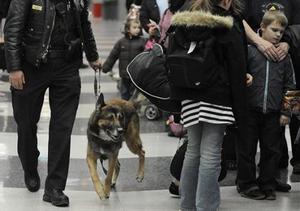Sniffing dogsA good nose for explosives
There is a new breed of explosive-sniffing dogs: vapor—wake dogs; genetically bred and trained by Auburn University’s College of Veterinary Medicine, vapor-wake dogs are taught to detect the scent plume of air that comes wafting off a person, such as a suicide bomber, wearing an explosive device

On the job // Source: dogster.com
It seemed like a normal morning last Wednesday as hordes of Senate staffers made their way through the Lower Senate Park to get to work by 9 a.m. Owen, one of the U.S. Capitol Police’s newest hires, was weaving through the crowds, conducting serious undercover work. Owen has been rigorously trained in a cutting-edge explosive-sniffing technique known as vapor wake. Owen also has a tail that wags. He is a black Labrador.
The Hill’s Jordy Yager writes that Owen and his handler, Officer Jeff Core, walked alongside the scores of unsuspecting staffers, subtly sniffing the wafting scent of each person. Their goal: sniff out a plainclothes Capitol Police officer who had five large sticks of inactive dynamite hidden in a vest underneath his plaid collared shirt.
Owen’s nose perked suddenly. He pulled at the black leash in Core’s hand as the last of the staffers passed by. With Core in tow, Owen gracefully weaved his way up through the center of a group until he found the dynamite-strapped officer and proceeded to point at the man’s back with his nose.
Yager writes that Capitol Police is one of the first major law enforcement agencies to employ this new canine vapor-wake technology, and Owen’s performance last week was part of a demonstration for officers visiting from the New York Police Department and the Bureau of Alcohol, Tobacco, Firearms and Explosives. Both agencies are thinking about investing in the $20,000 dogs.
Genetically bred and trained by Auburn University’s College of Veterinary Medicine, vapor-wake dogs are taught to detect the scent plume of air that comes wafting off a person, such as a suicide bomber, wearing an explosive device.
A standard explosives-detection canine is trained to sniff out a stationary explosive odor, but a vapor-wake dog can detect the moving scent of an explosive odor, even in large, moving crowds with hundreds of competing smells.
Capitol Police has been deploying the four vapor-wake-trained dogs on Capitol Hill over the past month. The dogs are sent out at random so that no one will know exactly where they are at any given moment, Canine Training Supervisor Sgt. Charles Abernethy said. And each of the dogs gets at least one decoy a day, like the officer wearing dynamite last week, so that their training stays fresh.
“The K-9 Vapor Wake Detection Program is part of our commitment to employ cutting-edge technology and assets to counter current and emerging threats,” Capitol Police Chief Phillip Morse said in an e-mail.
Yager notes that the vapor-wake dogs work in tandem with two specially trained officers, called Subject Interdiction Officers (SIOs), who are deployed with the dogs and trained to watch passers-by to identify possible attackers. So when Owen signals that he has found someone with an explosive odor on him or her, one SIO decides how best to stop that person, while Owen goes directly back to sniffing out more explosive odors drifting in the air in case he can discover a second would-be attacker.
Because the job of a vapor-wake dog is to detect odors on people, Capitol Police make sure to expose the animals to a variety of people and scenarios that could be distracting or confusing — like busy Metro stations, people in wheelchairs or a person with a baby stroller. Last Wednesday, though, Owen seemed focused on one thing. He busily sniffed staffers as two nearby pigeons sprang up into the air just two feet from him. Owen’s attention? Not even a flicker of distraction.
“As a trainer you try to defeat the dog because it makes them better,” Abernethy said. “But these dogs are so intelligent that it leaves us scratching our heads at a loss for how we can defeat them. And we haven’t, but we’ve tried.”
